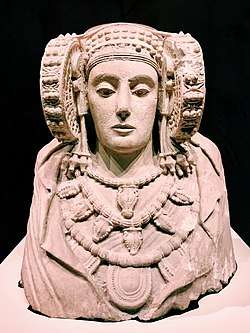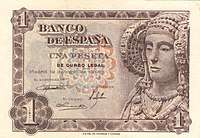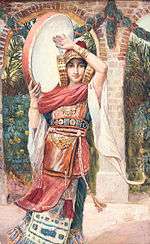Lady of Elche
The Lady of Elx or Lady of Elche (in Spanish, Dama de Elche) is a limestone[1] bust that was discovered in 1897, at La Alcudia, an archaeological site on a private estate two kilometers south of Elche, Spain. It is currently exhibited in the National Archaeological Museum of Spain in Madrid.

It is generally known as an Iberian artifact from the 4th century BC, although the artisanship suggests strong Hellenistic influences.[2] According to The Encyclopedia of Religion, the Lady of Elche is believed to have a direct association with Tanit, the goddess of Carthage, who was worshiped by the Punic-Iberians.[3]. Similarly, the sculpture presents features of the Celtiberian culture (the mitre and the pendants) and the own Iberian (fibula).
Sculpture
The originally polychromed bust is thought to represent a woman wearing an elaborate headdress and large wheel-like coils (known as rodetes) on each side of the face. The opening in the rear of the sculpture indicates it may have been used as a funerary urn.
Other artifacts associated with Iberian culture are the Lady of Guardamar −which has similar wheel-like rodetes and necklaces− or the Lady of Baza. While the Lady of Elche is a bust, there are indications that it was part of a seated statue, similar to the Lady of Baza (with which it shares similar necklace pendants) or a standing one like the Gran Dama Oferente from Cerro de los Santos (Montealegre del Castillo, Albacete).
These three figures and the Bicha of Balazote are exhibited in the same Iberian art hall in the National Archaeological Museum of Spain in Madrid.
Discovery and repatriation

The sculpture was found on 4 August 1897, by a young worker, Manuel Campello Esclapez. The popular version of the story differs from the official report by Pere Ibarra (the local keeper of the records) which stated that Antonio Maciá found the bust. Ibarra's version of the discovery story, was that farm workers clearing the southeast slope of La Alcudia for agricultural purposes, discovered the sculpture. The bust was quickly nicknamed "Reina Mora" or "Moorish Queen" by locals.[1]
An archaeological site is now located where the bust of Elche was discovered. Evidence has been found there of an Iberian-Punic settlement, a Roman sewer, walls and Roman houses, and mosaics. One mosaic shows an effigy of Saint Abdon, belonging to a Christian basilica of the 5th century. The latter archaeological evidence is supported by the codices of the councils of Toledo where it discusses an audience with bishops from Illici (Elche).
Dr. Campello, owner of the farm, was married to Asunción Ibarra, daughter of Aureliano Ibarra Manzoni, a humanist from the 19th century whose hobby was archeology. Ibarra Manzoni had found a number of objects and Iberian vestiges on his own farmland and in other places in the municipality of Elche. He built up a valuable collection, which he bequeathed to his daughter Asunción. He provided instructions that she make the necessary arrangements for the collection to be offered for sale to the Real Academia de la Historia after her death, to be located finally at the National Archaeological Museum. The will specified that the collection be sold in its entirety. The family placed the Lady on their balcony so that it could be viewed by all of the residents of Elche.[1]
Don Pedro Ibarra invited French archaeologist Pierre Paris to his home to see the Mystery Play of Elche. When the archaeologist saw the Iberian bust, he recognized its worth and notified the Louvre in Paris. The Louvre offered a large sum of money for the time: 4000 francs, and purchased the sculpture within a few weeks of its discovery. Despite opposition from Doña Asuncion, the Iberian bust was sold. On 30 August 1897, the sculpture was sent to the Louvre.

For 40 years the Dama de Elche was exhibited at the Louvre. After the start of World War II in 1939, as a precaution, the sculpture was transferred for safe-keeping to the castle of Montauban near Toulouse.[1] The Vichy government negotiated the statue's return to Spain with Franco's government. In 1941 it was returned through an exchange of works (which also included the Immaculate Conception of the Venerable Ones (or Immaculate Conception of Soult) by Murillo, the twin sphinxes of El Salobral and several pieces of the Treasure of Guarrazar, and the Iberian sculptures of Osuna. In return Spain transferred to France a portrait of Mariana of Austria by Velázquez (the Prado kept another existing version of the portrait, which was considered of superior quality)[1] and a Portrait of Antonio de Covarrubias by El Greco.[4] Since 1941, the Lady of Elche has been officially owned by the Museo del Prado (catalog number E433).
The discovery of the Lady of Elche initiated a popular interest in pre-Roman Iberian culture. She appeared on a 1948 Spanish one-peseta banknote and was mentioned in William Gaddis's The Recognitions (1955).
In 1971 it was transferred from El Prado to the National Archaeological Museum of Spain,[5] where it is currently exhibited.
.jpg)
Exhibitions in Elche
In 1965 the Dama de Elche returned briefly to Elche, on the occasion of the seventh centenary of Mystery Play of Elche.
On 19 January 2006, the Minister of Culture of Spain, Carmen Calvo, issued a decision to temporarily lease the Lady to its hometown. From 18 May 2006, to 1 November 2006. the Dama de Elche presided over the inauguration of the Museum of Archaeology and History of Elche (in the Palace of Altamira) and the exhibition From Ilici to Elx, 2500 Years of History that took place in different locations in the city. It was represented by an exact replica afterwards.[6][7]
Contention of forgery
The bust was first accused of being a forgery in 1906, in an essay called 'Las esculturas del Cerro de los Santos, cuestion de autenticidad' by archeologist José Ramón Mélida.

In 1995, John F. Moffitt, an art historian specializing in painting,[8] published Art Forgery: The Case of the Lady of Elche, University Press of Florida, in which he contended that the statue was a forgery with similarities to symbolist art of the Belle Époque. He speculated that the identity of the forger and commissioner was "a physician and resident surgeon in the town of Elche" who was "well informed about the current state of Iberian studies" and owned "the fertile archaeological site of La Alcúdia."
Experts in Spanish archaeology have rejected Moffitt's theory and accept the Lady of Elche as a genuine ancient Iberian work. Antonio Uriarte of the University of Madrid has stated: "Decade by decade, research has reinforced the coherence of the Lady within the corpus of Iberian sculpture. The Lady was found more than a century ago, and many of its features, not then understood, have been confirmed by subsequent finds. For example, the use of paint in Iberian sculpture was unknown when the Lady appeared."[9] A Consejo Superior de Investigaciones Científicas (CSIC) study on the Lady of Elche's micropigmentation published in 2005 concluded that the trace pigments on the statue were consistent with ancient materials and that no modern pigments had been found.[10]
In 2011, María Pilar Luxán,[11] the author of the 2005 study, analyzed microparticles within the back hole of the Dama d'Elx utilizing electron microscopy and X-ray dispersive spectrometry. Luxán deduced that the particles belonged to the ashes of human bones and that they compared with those of the Iberian period. She concluded that the statue was used as a funerary urn in the Iberian period, thus guaranteeing its antiquity and confirming the hypothesis about its function.
In modern culture
French artist James Tissot based figures in several of his turn-of-the-century paintings on the recently discovered Lady of Elche.[12]

Dama de Elche was depicted on the 1948 1 Peseta banknote.
The Dama de Elche makes an appearance in Part III of William Gaddis's 1955 novel The Recognitions, when the character Wyatt Gwyon examines a one peseta note and calls the engraving of the bust a "beautiful thing".[13]
See also
- Dama del Cerro de los Santos
- Carthaginian Iberia
- Contestani
- Iberians
- Lady of Guardamar
References
- "Misterios sin aclarar de la Dama de Elche". ABC (Spain). 4 August 2016.
- Francisco Vives Boix, La Dama de Elche en el año 2000 : Análisis tecnológico y artístico .
- , Macmillan Library Ref. USA - Iberian Religion - page 549
- Prado. "Encyclopedia of the Prado/Timeline museum/1941". Retrieved 28 April 2009.
- Prado Museum. "Enciclopedia On-Line/Dama de Elche (anonymous)". Retrieved 29 April 2009.
- Facsimile of the Dama de Elche executed by Adam Lowe's studio Factum Arte in Madrid (2002-2005) accessed 14 November 2014
- Museo Arqueológico y de Historia de Elche (MAHE) Archived 1 November 2014 at the Wayback Machine, accessed 14 November 2014
- "Jack Moffitt, 1940-2008". klowry.com. Archived from the original on 4 March 2009.
- R. Olmos and T. Tortosa, in Gocha R. Tsetskhladze (ed.), Ancient Greeks West and East, Leiden: Brill, 1999, brief summary here
- M. P. Luxán, J. L. Prada, F. Dorrego, 2005, "Dama de Elche: pigments, surface coating and stone of the sculpture", Materials and structures, 38(277), pp. 419-424. See also
- Luxán, Mª P. et al (2011). Human bone ashes found in the Dama de Elche (5th-4th century B.C.) reveal its use as an ancient cinerary urn. Journal of Cultural Heritage vol. 12, issue 3, pp. 310-316.
- "Picture - The BAS Library". bib-arch.org.
- Gaddis, William (1985) [1955]. The Recognitions. Penguin Books. p. 782. ISBN 978-0-14-007768-1.